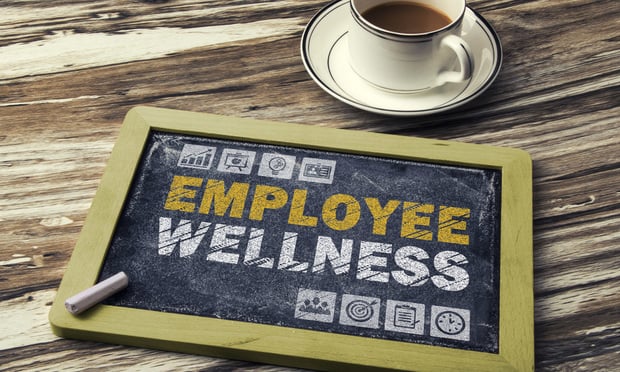 A chalkboard that says "employee wellness" lays on the ground next to a cup of coffee.
A chalkboard that says "employee wellness" lays on the ground next to a cup of coffee.
The momentum for employee wellness programs continues to gather steam among U.S. employers, and that’s no surprise, given the wealth of benefits that a well-designed wellness strategy can drive.
With a well-designed initiative, you can create a wellness effect with an impact goes way beyond just physical health in boosting the overall wellbeing of the workforce. When you weave wellbeing into the culture, engagement and motivation are optimized, absenteeism and presenteeism can be reduced, and employee morale, overall productivity and physical health, too, will all trend favorably.
Recommended For You
These trends will lead to higher performing workers, which are an element of industry research that show firms with exceptional health and safety programs also have better performing stock – 325% ahead of the Standard and Poor’s 500 index fund, one study found.
Capitalizing on the benefits, though, may be easier said than done. The Integrated Benefits Institute found low participation is an issue in wellness offerings, with employers citing weight loss (63%), nutrition (50%) and mental health (56%). Among the perceived barriers: lack of time (60.9%); limited interest (36.9%); and lack of awareness/access (34.2%).
Creating a robust and impactful employee wellness program is a multi-faceted endeavor. It takes certain best practices that are integral to building the framework of a program that delivers the best outcomes.
Two of the most important building blocks can also be the most challenging to put into place. One is the sort of support structure that fosters connectedness and engagement. Another is wellness programming that is well-integrated, and relevant to a diverse employee population. Plus, with participation, strategies go beyond “incentives” and communications are tailored to a hybrid workplace.
The outsized influence of a supportive culture
Organizational and leadership support play a leading role in a winning wellness strategy.
Getting there takes a relentless focus on nurturing a human-centric culture, where employee well-being and satisfaction are priorities, and a concerted effort is aimed at strengthening connectedness among individuals, across teams and the organization.
Among other benefits, a human-centric culture grows high-performing employees who, importantly, are proud of their organization, and feel valued and encouraged to provide feedback to help improve their environments. This enhances engagement and ultimately works to improve recruitment and retention, particularly of the increasingly important millennial workers who, by 2025, will comprise 75% of the global workforce.
The initiative must align with the company’s mission and values, and its leaders must demonstrably walk the wellness talk. This can take the form of ghostwritten blog posts or letters in house communiques that show how they’ve dealt with wellness issues, or by scheduling periodic “wellness appearances” with employee groups.
Further, policies must be created that align with employees’ every day real life, not just life events, and remove barriers like cost and stigma to accessing existing resources. Traditions like “Donut Fridays” send a message. Consider instituting a Healthy Food at Work days instead. Make the healthy choice, the easy choice using an outside vendor or having a kitchen space where real food can be prepared. Ensure leave policies respond to
Integrated programming is important
An effective wellness program is based on the premise that every dimension of an employee’s performance and health is connected. The goal is to deliver a quality employee experience with customized wellbeing assists at each of those connection points – career and growth, money and security, culture and connection, health and energy, productivity, communication and engagement. The “silver bullet” is meeting people where they are with resources to support their unique journey to optimal wellbeing.
An integrated program structure is effective and efficient. By aligning complimentary resources, it encourages access to more targeted and relevant resources.
One HUB client took this approach to increased demand for mental health support, surging behavioral health resources: an Employee Assistance Program, a behavioral health telehealth service, and third-party mental health counseling. The client also implemented a coordination of care model, increasing engagement and maximizing investment. From intake to follow up, the improvement levels improved: anxiety, by 35%; depression, by 39%; and stress, by 34%.
If you build it, will they come?
Arguably, driving participation may be the biggest challenge to successful wellness programs. Incentives alone won’t do the job. Shared ownership may.
Great communications matters. Four measures thus have become critical. First is the need to brand the program. A look, a voice, an identity all help to support the story. Second is the role of a single source of truth – a wellness portal or website – for the program, where messaging is streamlined, and programming is integrated. Another is the need to use video liberally, especially given today’s information consumption habits. And finally, information should be kept short and sweet in keeping with today’s literacy levels and short attention spans.
Some workable ideas to increase participation include:
- Create movement challenges, enterprise-wide, with teams formed according to function.
- Provide seed money for local offices to create their own wellness initiatives.
- Involve supervisors and managers in strategic planning – giving them a voice, not just a task.
- Make wellness relevant and connected to the work environment.
- Design a work environment that supports healthy choices.
© 2025 ALM Global, LLC, All Rights Reserved. Request academic re-use from www.copyright.com. All other uses, submit a request to [email protected]. For more information visit Asset & Logo Licensing.







